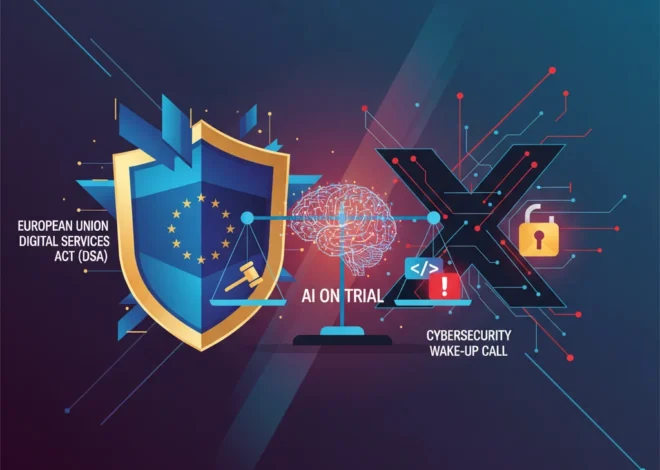
Meta’s $8 Billion Problem: Why the EU’s New Law is a Game-Changer for All of Tech
Picture this: You wake up, grab your coffee, and check your company’s inbox. Waiting for you is a notice from the European Union. The subject? A potential fine. The amount? Not a few million, but up to 6% of your company’s entire global annual revenue. For a company like Meta, that’s a figure north of $8 billion.
This isn’t a hypothetical scenario. It’s the reality Meta is facing right now. The European Commission has officially accused the tech giant of breaching its landmark new internet rules by failing to adequately police illegal content and foreign disinformation on Facebook and Instagram. This isn’t just another slap on the wrist; it’s the first major test of the EU’s ambitious Digital Services Act (DSA), and the outcome could send shockwaves through the entire tech industry—from established giants to budding startups.
So, what exactly is happening, and why should you, whether you’re a developer, an entrepreneur, or just a tech enthusiast, be paying close attention? Let’s break down this high-stakes confrontation and explore its deep implications for the future of software, artificial intelligence, and online innovation.
Decoding the Accusation: More Than Just “Bad Content”
At the heart of the EU’s case is the Digital Services Act (DSA), a comprehensive piece of legislation designed to make the internet a safer place. Think of it as the new, mandatory rulebook for online platforms operating in Europe. The EU’s concern isn’t just about a few harmful posts slipping through the cracks; it’s about what they see as a systemic failure.
The core allegations against Meta include:
- Inadequate Takedown of Illegal Content: The EU claims Meta’s systems for users to report illegal content aren’t effective or user-friendly enough, failing to comply with the DSA’s stringent requirements.
- Failure to Combat Disinformation: With the critical European Parliament elections just around the corner, regulators are deeply concerned about the spread of foreign-sponsored propaganda and disinformation campaigns designed to manipulate public opinion. They believe Meta’s content moderation, which relies heavily on automation and AI, isn’t up to the task.
- Lack of Transparency: A key pillar of the DSA is transparency. The EU alleges that Meta hasn’t provided researchers with sufficient access to public data, making it difficult for third parties to study and understand the spread of disinformation on its platforms.
This isn’t a simple bug fix. It’s a fundamental challenge to the core operational model of social media platforms, which are built on algorithms designed for engagement, not necessarily for civic safety. The EU is essentially saying, “Your business model is creating societal risks, and you’re not doing enough to mitigate them.”
Caught in the Crossfire: Why Europe's Tech Future is Hostage to the US-China Mineral War
The AI Arms Race: Technology as Both the Problem and the Solution
This entire conflict highlights a fascinating and complex technological paradox. The very tools fueling the problem are also our best hope for a solution. We’re in the midst of a full-blown arms race powered by artificial intelligence.
On one side, bad actors are leveraging generative AI to create hyper-realistic deepfakes, sophisticated propaganda, and armies of bots at an unprecedented scale. They can tailor disinformation to specific demographics and languages, making it incredibly difficult to trace and debunk. This is a massive cybersecurity threat that goes beyond traditional hacking and targets the very fabric of our information ecosystem.
On the other side, platforms like Meta are deploying complex machine learning models to detect and flag this content. These systems, running on massive cloud infrastructure, sift through billions of posts, images, and videos every day. They use natural language processing (NLP) to understand context, computer vision to identify manipulated media, and pattern recognition to spot coordinated inauthentic behavior. The software behind this is a marvel of modern programming and engineering.
However, this AI-powered defense has its limits. The models can struggle with:
- Nuance and Context: An AI might not understand satire, sarcasm, or cultural-specific slang, leading to both false positives (censoring legitimate content) and false negatives (letting harmful content through).
- Adversarial Attacks: Malicious actors constantly probe these systems for weaknesses, slightly altering images or text to evade detection—a digital cat-and-mouse game.
- Scale and Speed: The sheer volume and velocity of content uploaded make it impossible for human moderators to review everything, forcing a heavy reliance on imperfect automation.
This is where the EU’s investigation gets particularly interesting. They aren’t just looking at whether Meta is trying; they’re assessing if their entire system—the combination of human processes and AI-powered software—is fundamentally robust enough to handle the “systemic risks” their platforms pose.
The Billion-Dollar Bottom Line
Let’s talk numbers. The threat of a fine up to 6% of global annual revenue is a powerful motivator. To put that in perspective, we’ve broken down what that could mean based on Meta’s recent financial performance.
Here’s a look at the potential financial impact:
| Metric | Figure | Source / Calculation |
|---|---|---|
| Meta’s 2023 Global Revenue | $134.9 Billion | Meta Q4 & Full Year 2023 Results |
| Maximum DSA Penalty Rate | 6% | Financial Times (DSA Provision) |
| Potential Maximum Fine | ~$8.1 Billion | Calculation: $134.9B * 0.06 |
A fine of this magnitude would be one of the largest regulatory penalties ever levied against a tech company. But the financial hit is only part of the story. A guilty verdict could force Meta to make fundamental, and potentially costly, changes to its algorithms, its ad-targeting systems, and its entire approach to content moderation. It could set a global precedent, emboldening other countries to adopt similar, aggressive regulatory frameworks.
Beyond the Zap: How Taser's Maker is Building a Controversial AI-Powered Future for Policing
The Ripple Effect: What This Means for the Broader Tech Ecosystem
While Meta is the one in the hot seat, the implications of this case extend far beyond its headquarters. Every company that operates online should be watching closely.
For Developers and Tech Professionals:
The demand for professionals who understand the intersection of programming, ethics, and regulation is about to explode. Skills in building “Trust and Safety” features, developing ethical AI, and enhancing cybersecurity are no longer niche; they are becoming core competencies. If you can build software that is not only innovative but also compliant and safe by design, you will be invaluable.
For Entrepreneurs and Startups:
The regulatory landscape is becoming more complex. For startups, this presents both a challenge and a massive opportunity. The challenge is the daunting cost and complexity of compliance. However, this complexity creates a need for new solutions. A new generation of “RegTech” startups is emerging, offering SaaS platforms that provide everything from AI-driven content moderation to automated compliance reporting. There is immense room for innovation in creating tools that help other companies navigate this new reality.
For the Future of the Internet:
This case represents a fundamental philosophical shift. For two decades, the internet was largely self-regulated, guided by the principle of platform immunity. The DSA effectively ends that era in Europe. It codifies the idea that platforms have a societal responsibility for the content they amplify and the risks they create. Whether this leads to a safer, more responsible internet or a fragmented, overly censored one remains to be seen. The EU’s move is a bold step towards the former, but the path is fraught with technical and ethical challenges.
Spotify's New AI Symphony: Harmonizing with Labels or Composing a Crisis?
Conclusion: A New Chapter for the Digital Age
The EU’s confrontation with Meta is far more than a regional regulatory dispute. It’s a defining moment that crystallizes the central tension of the modern internet: the conflict between engagement-driven platforms and the need for a safe, reliable information ecosystem. It’s a battle being fought with lines of code, machine learning models, and legal frameworks.
The outcome will not only determine Meta’s financial fate but will also set the standard for platform accountability worldwide. It will shape the future of AI development, influence cybersecurity priorities, and create new markets for tech innovation. This is the new reality for the tech world—one where success is measured not just by user growth and revenue, but by responsibility and trust.

